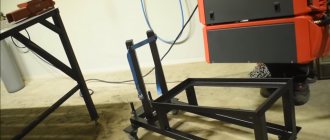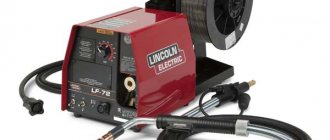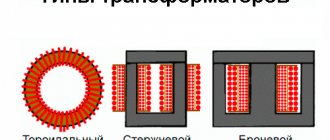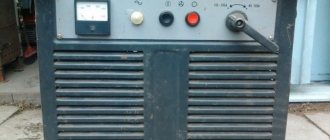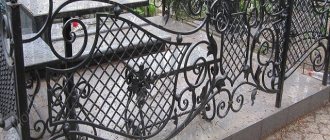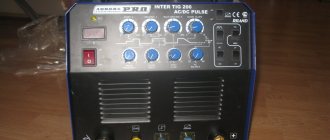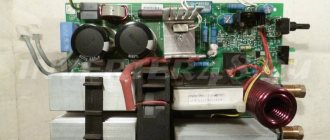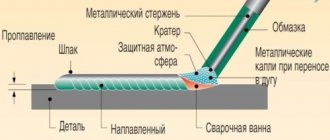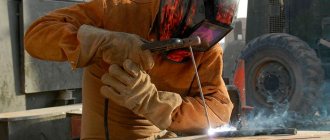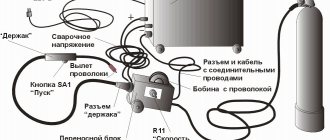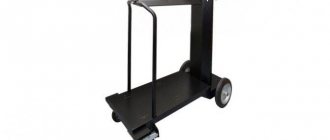A medium-power semi-automatic welding machine itself weighs a lot. In addition, a cylinder with protective gas, a hose, a torch, wires, and a mask must be delivered to the welding site. The tool for preparing the welding zone, cleaning seams, a supply of welding wire, and other consumables also takes up space and weighs a lot. A semi-automatic cart is useful for this. Everything you need for work is conveniently placed on it. Such products are mass-produced and have two, three or four wheels. Experienced craftsmen are not satisfied with industrial designs; they design and independently make carts “for themselves.”
Buy or make
When a need arises for a welding cart, the question almost always comes up: “Should I buy it or make it myself?” Both options have both pros and cons, and now about each of them.
Car from the store
If you have a certain amount of money, it is not difficult to buy a cart with the required configuration
But is she worth it? Yes, the assortment is fascinating, and the wide price range will please anyone, but before purchasing you should pay attention to:
- Manufacturer. It is not advisable to purchase Chinese-made products. Such carts are very fragile, as they are made of thin-walled pipes.
- Load capacity. It must correspond to that declared by the manufacturer.
- Quality of welds. Seams that are cleaned for beauty often become the reason for the unreliability of the entire structure.
- Value for money.
Homemade trolley
But it’s not always possible to find a cart of the right size and configuration. If you still decide to save money and make a cart with your own hands, then first you should decide on the configuration and take the necessary measurements. Additionally, you can make a drawing of the future device, or take it publicly available on the Internet.
The next step will be collecting materials. For this purpose, cuttings of any metal pipes, corners, plates, etc., which are often left over after welding, are suitable. Such trimmings can be easily purchased in stores for a nominal price or found in a landfill (this also happens).
After this, all parts are carefully measured, cut and, if necessary, polished. Then the welding process itself begins, which it is advisable to start with the frame to ensure the strength of the entire structure. Once the frame is ready, you can safely move on to the shelves, wheels and other contents.
Expert opinion Bagrov Viktor Sergeevich Welder of the highest 6th category. He is considered a master of his craft, knows the intricacies and nuances of the profession.
Do not forget that when working with filler wire, its composition and the composition of the cart metal must be the same, which will ensure the creation of strong welds. Subsequently, minor sanding of the seams is allowed for the beauty of the product.
After assembling the main structure, it is necessary to provide access to the bottom in order to weld the wheels, and the mounting method must be selected in accordance with the weight and carrying capacity of the cart.
The homemade welding cart is ready, it turned out to be reliable and economical. If you want to paint the structure, it is recommended to use spray paint.
The welding machine trolley is a complete mobile station for the welder’s working tool. You can purchase a ready-made one in a store, saving time, or you can make it yourself from leftover pipes and plates and become the owner of a unique design. The main thing is to approach this issue with the utmost care, and also not to load the cart beyond its useful capacity.
Types of auxiliary mechanisms
Various mechanisms and auxiliary parts are made at factories and at home. The simplest of them are easy to make with your own hands. In general, welding aids come in three types:
- mechanisms for installation, assembly, preliminary fixation;
- clamping devices;
- combined devices.
The first type of fixture is used to install parts in the position required for welding. Clamping welding fixtures firmly fix them and prevent them from slipping or turning. Combination devices perform both functions.
There are certain requirements for auxiliary devices. They must ensure free movement of the parts being welded caused by heating in the welding zone.
If large-sized products are welded, it is necessary to ensure fastening only at the welding points. The welder must be provided with free access to the welding site. It is also necessary to ensure rapid removal of the generated heat.
Cooking devices can be special or universal. For example, a special stand for assembling and welding frame products is a table with clamps.
Universal stands look the same, only they have additional devices for fastening the product, and due to this they can fix a large range of workpieces.
Clamps include devices that ensure a stable position of the welded product. They are made in the form of pockets, stops, mounting pins, prisms and templates.
Removable stops are used in universal stands when it is necessary to adjust for a specific product, or it is impossible to remove the product without deforming it.
Fingers allow you to accurately position the workpiece; they are usually used when working with products that have machined planes. Prisms are used when welding various pipes.
Templates are a design that follows the contour of the product being welded. The parts are installed in a template, welded, and the result is identical products when the welding process is repeated. The part itself becomes the load-bearing element, and the template sets the shape.
When making a single product, sometimes fixation is required in a non-standard way. It also happens that the necessary equipment is not at hand.
In this case, the welder makes it himself from scrap materials. To make homemade welding fixtures, a few pieces of corners and a pair of clamps are enough.
With their help you can get a simple and reliable lock. If you need to get a clamp for a connection at a right angle, just weld the corners perpendicular to each other and grab them with a third corner.
By welding the clamps in the right places, a clamp is obtained for perpendicular connection of products. That is, if necessary, the welder can provide himself with the required devices.
Varieties
Centrifugal pumps: principle of operation, design and classification by type
From the variety of models, it is worth distinguishing three main types according to the type of capacity: for a cylinder, for an inverter, for a semi-automatic device with a cylinder. Now more about each of them.
- For a cylinder. When transporting the cylinder separately from the welding unit, a two-wheeled vertical wheelbarrow of a simple design with additional mounts for the cylinder is usually used.
- For converter. To transport a welding machine, vertical trolleys are also most often used, since their useful capacity is greater than that of horizontal ones, and they take up little space at the base. You can build shelves on them and transport one or more inverters at the same time. It's also easy to add drawers and fixtures to store work equipment.
- For a device with a cylinder. Of all the varieties, the semi-automatic cart with a cylinder is the most popular. This is because the welding machine and the carbon dioxide cylinder are located nearby and are convenient for movement and work. Such cars come in two, three, and four wheelers. They have an impressive carrying capacity (from 250 kg and more), often several shelves, and also have storage space for work equipment.
Homemade electrode holders
General view of a simple electrode holder made from a d¾” pipe: 1- electrode; 2 - spring; 3 - pipe; 4 - rubber hose; 5 — screw and nut M8; 6 - cable.
Homemade devices of this type have the greatest variety. This is due to the fact that, for example, the wires going to the inverter welding machine are too short. The types of holders mainly depend on what types of work will be performed. They will differ significantly depending on whether thick and durable pipes are welded or wires are soldered when connecting or twisting.
So, for example, take a steel rod and three pieces of wire about 10 cm long, 8 mm thick in diameter. We bend two pieces of wire only slightly to the side, as for a fork, taking into account that these parts will have different sides: left and right. In the middle there will be a third part of the wire, bent upward from the side adjacent to the metal rod, to approximately half its length. First, the side parts are tacked by welding, then the missing part is applied in the center, everything is welded well
This extra precaution is necessary in case of welding thick pipes; additional winding of the wire will protect it from overheating. Eventually:
- two parts of the wire, located on the rod, have the same length;
- the third leaves a sort of small gap;
- prepare an insulated wire in advance, stripped on both sides and wrapped with thin wire around the edges;
- cut out a thick, rubber piece of material that will be the handle of the holder;
- it is welded to the middle part of the wire;
- immediately after welding, while the fixture is hot, apply a gasket;
- the second end of the wire, wrapped and stripped, is clamped with a natural welding machine holder.
The device is ready for use, now the welder can move a much greater distance to perform the work.
Execution options
Inspection of cylinders
The easiest way is to make a four-wheeled cart with a horizontal cylinder. The main disadvantage of this design is the large length, which makes maneuvering in small rooms difficult. It is inconvenient for one person to place and remove the cylinder.
Therefore, semi-automatic carts with a vertical cylinder arrangement are more popular. They usually have a shelf above the welding machine where tools can be stored. If you replace two swivel wheels with one, it will be easier to control the cart, but stability will deteriorate.
Two-wheeled structures, made on the wheelbarrow principle, are compact, maneuverable, and require a minimum of materials for their manufacture. The platform for the gas tank, located on the ground, is an additional support point. One person can install the cylinder on it using the tilting method.
Popular manufacturers
Gas cylinder sizes
The manufacturer's rating reveals the Aurora Pro 14768 model for transportation. The wheelbarrow is designed to move a semi-automatic welding machine with a cylinder.
The cart also has shelves for storing and transporting work equipment.
Shelf dimensions:
- top - 28x44 cm;
- medium - 28x38 cm;
- bottom - 29x41 cm;
- for a balloon - 29x26 cm.
The Ferrline CH-46 model has a reliable and durable design that can withstand loads of up to 46 kg. Has shelves for converter, cables and additional welding tools. The chains act as clamps for the cylinder. Like the previous model, the cart has a high base. This greatly simplifies setting up the device. The front swivel wheels are made of solid rubber, which increases maneuverability on uneven surfaces.
Trolley ST-1. Intended for transportation of semi-automatic welding machines with a cylinder. Durable design weighs 29 kg. Convenient for transporting equipment in workshops, production and garages.
Transport wheelbarrow from Kemppi PM-500. The Finnish trolley model is durable and mobile. Comfortable handles allow you to easily operate the device without much effort. The base is 4 wheels. Two wheels are swivel. The trolley is used to move semi-automatic machines in production conditions with a flat floor.
Kemppi ST-7. Two-wheeled wheelbarrow. The back part has a scoop-shaped platform for placing the cylinder. The design is very stable thanks to the durable material and vertical base. Light weight (12 kg) allows you to transport equipment in production conditions on uneven surfaces.
Wheelbarrow RedHotDot 033931. The trolley model has a steel, durable design with a tray for a cylinder. The swivel front wheels are made of solid rubber, which provides comfortable transportation and improved maneuverability. The wheelbarrow allows you to transport welding equipment even on uneven surfaces. The weight of the cart is 82 kg, which is considered considerable.
Wheelbarrow EWM Trolly 55-5. The steel 4-wheel design has a secure base and comfortable handles. Designed to move a semi-automatic welding machine with a cylinder. The cart is intended to be used on uneven floors. The weight of the cart is 35 kg. Length - 1 meter 13 cm, width - 50 cm, height - 1 meter 10 cm.
Model Eastwood MigTig Plasma Welding Cart 350. A high-quality and reliable product for transporting a semiautomatic welding machine with a cylinder. Has 3 shelves for transporting several inverters and additional welding tools. Reliable fixation is ensured by a special Tig Rod clamp. The body has reinforced, rubberized, cast wheels. The open back allows access to wires. There are also special hooks for cables.
Cart for moving equipment Welding Cart Welder Plasma Cutter Cart-3. The wheelbarrow is perfect for transporting a welding unit in a home garage or workshop. The cart body is made of high quality steel. The robust steel construction features rigid front wheels for increased maneuverability. Rubberized rear wheels provide additional stability. Several shelves provide space for the inverter and tools.
released a universal TU model. The wheelbarrow is designed to move not only a semi-automatic machine, but also other welding equipment. The steel and durable body has a base with front wheels for improved maneuverability. Large rear wheels increase the stability of the entire structure. Maximum load - 150 kg.
Technological components
For the manufacture of trolleys, a metal profile of round or rectangular cross-section is used. For the platform, steel sheets, expanded metal mesh or a transverse set of corners are used. The blanks are welded together, then cleaned and painted with powder paints to protect the structural elements from corrosion.
If the device is used in enclosed spaces with a flat floor, cast wheels of small diameter are usually used. If you plan to go outside, choose pneumatic rollers with a larger diameter that can handle potholes and other obstacles.
The trolley must be equipped with a device that prevents its independent movement. For two-wheelers, this is a heel support; for three- or four-wheelers, wheels with a built-in pressure brake are used.
Three-wheeled model
A welding cart on three or four wheels is a mobile box with niches for installing equipment and storing various tools.
It will be preferred by a welder who constantly works in one room, when there is no need to transport the semi-automatic welding machine to other sites. Additional parts boxes keep everything at hand.
Homemade carts of this type are much larger in size than two-wheeled ones. Usually they are welded from a 40x25 profile pipe. When making it, it is necessary to take into account:
- gas cylinder diameter;
- Dimensions of semi-automatic welding machine.
If the device is installed in the lower part of the cart, then there should be a shelf on top, completely covered with a metal sheet to prevent small objects from falling into the body of the welding machine. To securely fasten the cylinder and power source, it is necessary to provide clamps, belts or chains with bolt fixation.
For those who are going to use a semi-automatic welding machine not only in the workshop, it is recommended to use wheels with a diameter of at least 25 cm. A roller with a diameter of 12 cm can be used as a rotary one.
The entire product must be primed and painted with enamel. Before painting, it is necessary to weld the ends of the pipes and sand all the edges so that there are no burrs.
A 40x25 mm pipe is used in the manufacture of the base of the device; for the remaining components, a 20x20 mm profile can be used. If you don’t want to make a cart for a semi-automatic machine yourself, then you can always buy the finished product at a welding supply store.
Manufacturing nuances
The cart frame for a semi-automatic machine with a cylinder can be made of the following materials:
- corner of equal or different angles with a wall thickness of at least 1.0 mm;
- a rectangular pipe with a cross-section of at least 40x20 mm or a square pipe with a cross-section of at least 30x30 mm and a wall thickness of 1.0 mm or more;
- round pipes with a diameter of at least 20 mm and a wall thickness of at least 1.0 mm;
- sheet metal with a thickness of 1.5 mm or more;
- combinations of the above materials.
The table shelves, the place on which the semi-automatic device is installed, and other devices can be made of corrugated aluminum or steel sheet and plywood, which should be covered with rubber or flooring material on top. The thickness of the metal sheet must be at least 2 mm, plywood at least 5 mm.
It is necessary to know exactly how many cylinders you plan to move and their capacity. The dimensions of the seat for them and the design of the clamp depend on this.
Attention! Many people attach cylinders to the cart with chains, but it is better to use clamps for these purposes. It's much more reliable.
The trolley for the semiautomatic device and the cylinder is manufactured in the following order:
- blanks of the required size are selected or cut from the selected metal. For cutting, use a hacksaw or grinder. Be sure to use an emery wheel to remove burrs from the cutting areas;
- The frame is initially made by welding. In this case, the grade of metal is taken into account, which determines the selection of filler material and its diameter, if the connection is made with it. Most often, such a structure is made of low-carbon steel. If frame parts are made using bending, then all elements must be pre-bent;
- The plates to which the wheels are attached are prepared. They can be bought in a retail chain or taken from products available in the household (for example, from a children's bicycle or an old cart). Wheels can be of different sizes;
- the structure is placed on its side, and the specified plates are welded to it. When making a durable frame, you can not prepare plates with wheels, but weld the wheels directly to it;
- Clamps with fasteners for fastening the cylinders are being prepared. The design must include fastenings at the bottom and top, as well as an oarlock for reliable installation of the cylinder;
- the seams are cleaned. This operation can be performed using a special attachment placed on an angle grinder or a grinder;
- the frame is coated with GF-1 primer;
- After the primer layer has dried, paint with PF-115 or another brand of enamel using a paint brush.
The ideal option for painting a semi-automatic cart is to paint the structure with a powder composition. It protects the product well from wear and prevents corrosion, and lasts much longer than painting with enamels. But this method of painting is only possible in a factory environment, and if it is possible to do this at an enterprise, then this will be the best option for painting the cart, which in this case will last for many years.
We ask those who have made a cart for a semi-automatic machine with cylinders with their own hands to share their manufacturing experience and post photographs of step-by-step manufacturing.
Design of a trolley for a semi-automatic welding machine
Most semi-automatic welding machines have the ability to weld in a protective gas environment. In this case, a cart for the welding machine is required, which could transport not only the power source itself with cables, mask and electrodes, but also a heavy gas cylinder with hoses and reducers. We are talking about transporting equipment around a workshop or other work site.
Execution options
You can find several options for making do-it-yourself carts for semi-automatic machines. Some involve the transportation of only the welding machine, others provide for the transportation of gas cylinders.
All of them have from two to four wheels, with one or two rotating. Some transport devices only require pushing, while others require tilting and then pulling.
One of the simplest and most reliable options is a trolley for transporting gas receivers with a little modification.
Brackets for attaching the welding machine are welded to the device. A semi-automatic machine is installed on them; if there is a separate water cooling unit, then it is attached with belts from below to the welding equipment.
Design Features
The base for the gas cylinder is welded so that when the cylinder and trolley are standing vertically, the wheels also touch the floor. This creates additional stability of the structure.
The base itself does not have a collar on one side and looks like a scoop. This makes it easier to install the cylinder on the cart; there is no need to lift it and you can turn it over. To transport a semi-automatic machine, it is enough to tilt the cart, you get a wheelbarrow that is maneuverable and easy to transport.
The handle is made of a regular water pipe, bent in a shape that is easy to move. At the top and bottom of the semi-automatic trolley, mountings for cylinders are provided. They can be made in the form of clamps or regular chains with bolt fastening.
When working remotely from the mains, an extension cord is often required. In such cases, some craftsmen additionally install reel extension cords on the semi-automatic welding trolley.
Often small brackets are welded to the main frame for storing various welding tools; it all depends on the imagination and needs of the owner of the equipment.
Three-wheeled model
A welding cart on three or four wheels is a mobile box with niches for installing equipment and storing various tools.
It will be preferred by a welder who constantly works in one room, when there is no need to transport the semi-automatic welding machine to other sites. Additional parts boxes keep everything at hand.
Homemade carts of this type are much larger in size than two-wheeled ones. Usually they are welded from a 40x25 profile pipe. When making it, it is necessary to take into account:
- gas cylinder diameter;
- Dimensions of semi-automatic welding machine.
If the device is installed in the lower part of the cart, then there should be a shelf on top, completely covered with a metal sheet to prevent small objects from falling into the body of the welding machine. To securely fasten the cylinder and power source, it is necessary to provide clamps, belts or chains with bolt fixation.
For those who are going to use a semi-automatic welding machine not only in the workshop, it is recommended to use wheels with a diameter of at least 25 cm. A roller with a diameter of 12 cm can be used as a rotary one.
The entire product must be primed and painted with enamel. Before painting, it is necessary to weld the ends of the pipes and sand all the edges so that there are no burrs.
A 40x25 mm pipe is used in the manufacture of the base of the device; for the remaining components, a 20x20 mm profile can be used. If you don’t want to make a cart for a semi-automatic machine yourself, then you can always buy the finished product at a welding supply store.
design features and drawings – Consumables and components on Svarka.guru
A medium-power semi-automatic welding machine itself weighs a lot. In addition, a cylinder with protective gas, a hose, a torch, wires, and a mask must be delivered to the welding site. The tool for preparing the welding zone, cleaning seams, a supply of welding wire, and other consumables also takes up space and weighs a lot. A semi-automatic cart is useful for this. Everything you need for work is conveniently placed on it. Such products are mass-produced and have two, three or four wheels. Experienced craftsmen are not satisfied with industrial designs; they design and independently make carts “for themselves.”
Characteristics
The purpose of such equipment is to ensure the mobility and convenience of the welder, to reduce the loss of time preparing for welding, dragging tens of kilograms of equipment, tools, and materials. With the help of a trolley, a full-fledged mobile welding station is created, which contains everything that is needed to perform a weld anywhere in a workshop, workshop or construction site.
The main characteristics of such trolleys are as follows:
- Load capacity. The structure must support the weight of the welding machine, cylinder, hose, wires, consumables, and auxiliary tools. The total easily adds up to a hundredweight, or even more.
- Sustainability. The design of the trolley must prevent it from tipping over, even if a passing assistant touches it or the welder pulls strongly on the hose.
- Capacity. In addition to the welding machine and gas cylinder, a large number of large and small-sized items need to be placed in convenient trays, boxes or hangers. They should not wobble or fall out while moving.
- Dimensions and maneuverability. A trolley for a semi-automatic welding machine with a cylinder should take up little space, the dimensions of the vehicle should allow it to pass through passages up to 70 cm and turn almost at a right angle.
In addition, the device should have easy movement and a comfortable handle.
Technical data
Manufacturers market several basic types of welding trolleys. Their main dimensions are determined by the dimensions of the welding machine and gas cylinder.
Typical parameters look like this:
- weight: 12-15 kg;
- overall dimensions: 1.25x0.35x0.71 m
- size of the platform for the device: 0.28x.45 m.
These parameters are specified based on the capacity and number of cylinders with which the mobile post needs to be equipped, as well as the selected layout.
The most popular two of them are:
- two-wheeled layout, a large-capacity cylinder is placed vertically, the platform for the device is located above the axis and parallel to it;
- three- or four-wheeled layout, dimensions are determined by the dimensions of the platform for the welder, cylinders of small or medium capacity are placed under the platform.
Two-wheeled options are created on the basis of a standard trolley for transporting 40- and 50-liter gas cylinders; a bracket holding the platform for the device is welded onto their vertical handle
Three- and four-wheeled models are created on the basis of mobile tool cabinets, to which cylinder mounts are added on the side or bottom.
Important 6 years congratulations
To increase convenience and improve the working conditions of the welder, the cart is equipped with compartments for storing small tools, reels for winding and storing hoses and wires, etc.
What to look for when purchasing
Before going to the store, you need to measure the dimensions of the welding machine and cylinder, determine their weight along with auxiliary equipment (hose, gearbox, cable, electrodes, etc.)
Having this data, special attention when purchasing is paid to:
- Load capacity. It is better to choose it with a reserve.
- Dimensions. A cart that is too large will be awkward to move in a small space.
- Quality of coverage. Preference should be given to models painted with powder paint.
- Wheels. If you plan to move equipment on open ground, for example in a country house, their diameter is selected from 25 cm.
It is desirable to have drums for winding the cable and hose. A shelf and a toolbox will not be superfluous.
A Question of Choice
The cart itself for welding equipment is not very different from ordinary carts. It is a vertical device for transporting welding equipment: an inverter, a cylinder, or a device with a cylinder and additional tools for work.
If you still need such a cart, then you should pay attention to some points and take them into account in the future:
- Load capacity. If you plan to transport a semiautomatic device with a cylinder, then the minimum capacity of the trolley must be at least 250 kg.
- Storage. Consider the presence of drawers, shelves and mounts for work equipment. Each additional element makes the structure heavier.
- Wheels. It is imperative to take into account the number, material and diameter of the hubs of each wheel. The smooth running, load-bearing capacity and maneuverability of the trolley depend on this.
- Dimensions. This aspect should be taken into account by those who deal with semi-automatic welding and plan to work on the road.
In addition to this, there are other nuances, for example, the type of welding trolley, but everyone has their own requirements for the tool.
Is it worth making a cart for a welding machine yourself or is it easier to buy one?
Welding machines of our time are much more convenient to use, which allows them to be used not only on the ground, but also at height. But such mobility is only possible with small, low-power receivers, which are used mainly in domestic conditions or due to inexperience. In order to work with semi-automatic welding and easily move from place to place, you will need ingenuity and transport.
The optimal solution to this problem is an equipment trolley. The convenient design will allow you to easily move the unit around the work site, and it will also make it possible to work on-site.
A Question of Choice
The cart itself for welding equipment is not very different from ordinary carts. It is a vertical device for transporting welding equipment: an inverter, a cylinder, or a device with a cylinder and additional tools for work.
If you still need such a cart, then you should pay attention to some points and take them into account in the future:
- Load capacity. If you plan to transport a semiautomatic device with a cylinder, then the minimum capacity of the trolley must be at least 250 kg.
- Storage. Consider the presence of drawers, shelves and mounts for work equipment. Each additional element makes the structure heavier.
- Wheels. It is imperative to take into account the number, material and diameter of the hubs of each wheel. The smooth running, load-bearing capacity and maneuverability of the trolley depend on this.
- Dimensions. This aspect should be taken into account by those who deal with semi-automatic welding and plan to work on the road.
In addition to this, there are other nuances, for example, the type of welding trolley, but everyone has their own requirements for the tool.
We make a cart with our own hands according to the drawings
Practice has shown that the optimal material for making a do-it-yourself welding trolley is a profile pipe with a cross-section of 20x40 mm and 20x20 mm. When used indoors on a flat floor, cast wheels are suitable; for outdoor use when moving on the ground, it is better to use pneumatic ones. The design can have certain variations, and we will look at two examples that can be modified in your own way.
The cart shown in the photo has two pairs of wheels of different diameters, two shelves for tools and a welding machine, and two places for 10-12 liter cylinders. The bases of the shelves are made of thick plywood.
The drawing does not show all dimensions in centimeters, but those indicated are quite sufficient for a homemade design. The large diameter rear wheels are mounted on M16 bolts welded to the frame. The front wheels are rotating furniture supports. Let's look at assembling the cart step by step:
- First you need to prepare the parts in accordance with the drawings. The frame is assembled from 20x40 pipes; 20x20 pipes are welded to the perimeter platforms as support for plywood sheets and cylinders. All metal must be cleaned before painting.
- First of all, we cook two flat figures of the sides of the cart.
- We weld M16 bolts to the rear of the cart along the axis of the cylinders.
- We install the sidewalls vertically and cook all the horizontal elements. Under sheets of plywood and cylinders we cook tubes with a cross section of 20x20 mm.
- We weld a piece of pipe with a cross-section of 20x40 mm to the rear crossbar of the upper platform for fixing the cylinders. We insert a nut and bolt into it and weld it to the inner walls of the pipe.
- We turn the frame over and cook the front supports from below. We clean the welding areas.
- We wrap the wheel supports and bolts in polyethylene, degrease and paint the metal. We hammer plastic plugs into the ends of the pipes. We install the rear wheels and plywood platforms.
- We place equipment and tools. We install the cylinders in the sockets and fix them with a cross member made of a 20x40 mm pipe and a bolt that is wrapped in a nut welded to the frame.
Probably for safety reasons, it is more correct to install the front supports with clamps. They are a little more expensive than usual, but the cart will not roll away on uneven surfaces. You can learn more about the assembly process using the following video.
Advantages of industrial designs
Considering that welding work is classified as complex and responsible, the presence of additional accessories and items intended for mobile carrying or long-term storage plays an important role in this. The advantages of industrial designs are as follows:
- The front part of the box body, bottom and back wall are made of a metal base.
- The side walls, as well as the closed part of the top in the form of a lid, are made of impact-resistant plastic with a suitable varnish coating.
- The service life is at least 5 years.
- The movable tray mechanism, as well as the built-in organizer components, are used to accommodate basic accessories and additional spare parts for inverter equipment.
- Universal and strong locks made of chromed metal add not only aesthetics, but also reliably protect the drawer from intentional opening.
An industrial case is more expensive than a do-it-yourself welding inverter box, but at the same time, you can use this device as a full-fledged working tool for storing and carrying a welding inverter.
Features of self-assembly of a case for a welding inverter
To assemble a box for a welder yourself, you need to have minimal knowledge of mathematics, in particular geometry, in order to correctly cut the structure and make a useful accessory for temporary storage of inverter equipment.
Important Congratulations for Lily
For independent purposes you will need:
| Options | Meaning |
| Plastic canister | Volume 30 liters |
| Blind rivets | Diameter 4.8 mm, different lengths |
| Loops | 2 pieces |
| Chest type latches for closing/opening elements | 2 pieces |
| Tin strips | 4-8 pieces |
| PVC pipe cuttings | At your look |
| Enlarged washer | Size M 5 |
| Linoleum trim | 1 piece |
Assembly instructions
- We cut off only the top part of the canister.
- We “glue” the upper part of the canister with strips of tin and use rivets. Be sure to push the edge of the strip beyond the edge of the cut-off part of the canister lid. You can use an additional edging option, which will then cover the bottom of the canister.
- We connect the lid to the rest of the canister using furniture hinges; if necessary, use a regular grinder to cut the ends of the hinges to the desired size.
- In the places where the hinges are strengthened, we increase the size of the holes to 5.0 mm and secure them using blind rivets.
- We fasten the chest latches (that is, latches, not locks) on a tin strip so that both parts of the structure of the cut canister can later be closed.
- We take plastic PVC pipes, make “oblique” cuts on both sides of the pipe, choose the quantity yourself, the optimal option for pipe pieces is 4 pieces.
- On the PVC pipes where the bevel was made, we make holes for later fastening with rivets to the side of the lower structure of the canister. We connect it to the wall of the canister using an enlarged washer.
- PVC tubes can be used for electrodes and a regular metal hammer for welding.
- We also “treat” a piece of linoleum with a tin strip, which will become a “pocket” for grinder wheels.
- We rivet the pocket to the inside of the canister with rivets, giving it a pocket-like shape.
- Using a feather drill, we make holes along the bottom edge of the canister, so you can create ventilation for storing tools and a welding machine, while preventing condensation inside the structure.
- The box is ready for use.
This can accommodate all the wires and cables of the machine, as well as the welding helmet. The canister handle at the top will serve as a means of carrying tools and the apparatus. Everything is very practical, accessible and effective! Now you just have to make a choice - buy a ready-made case for a welding inverter, or make a box yourself.

